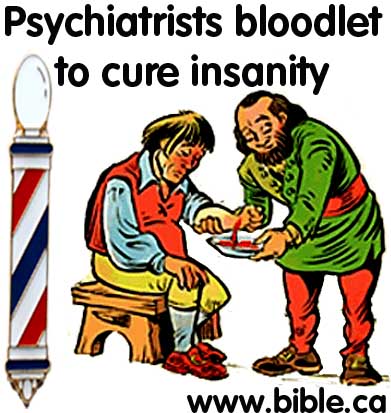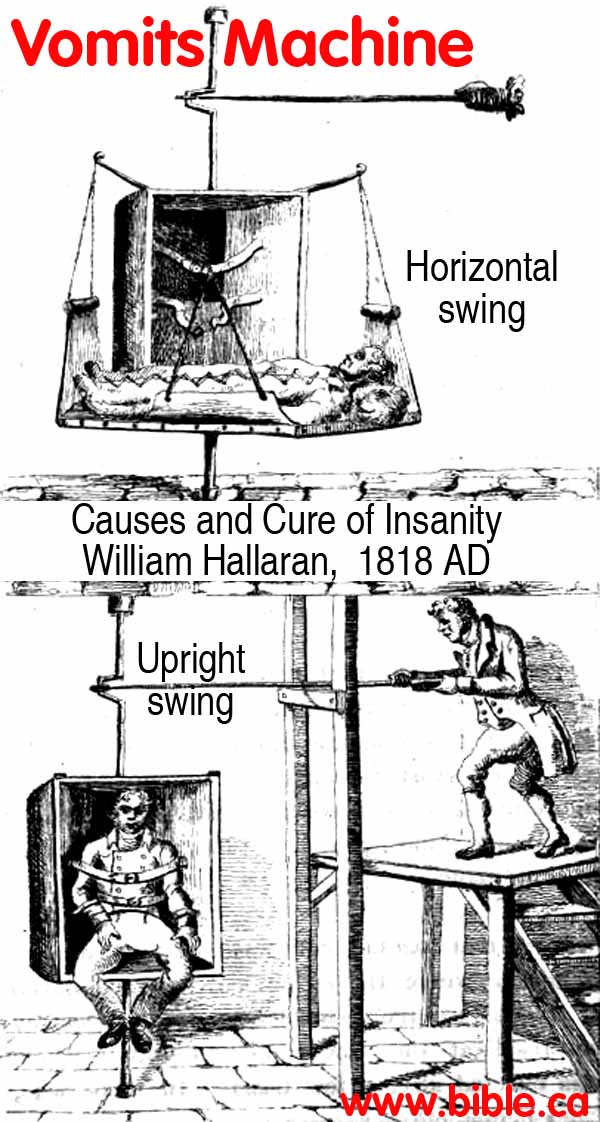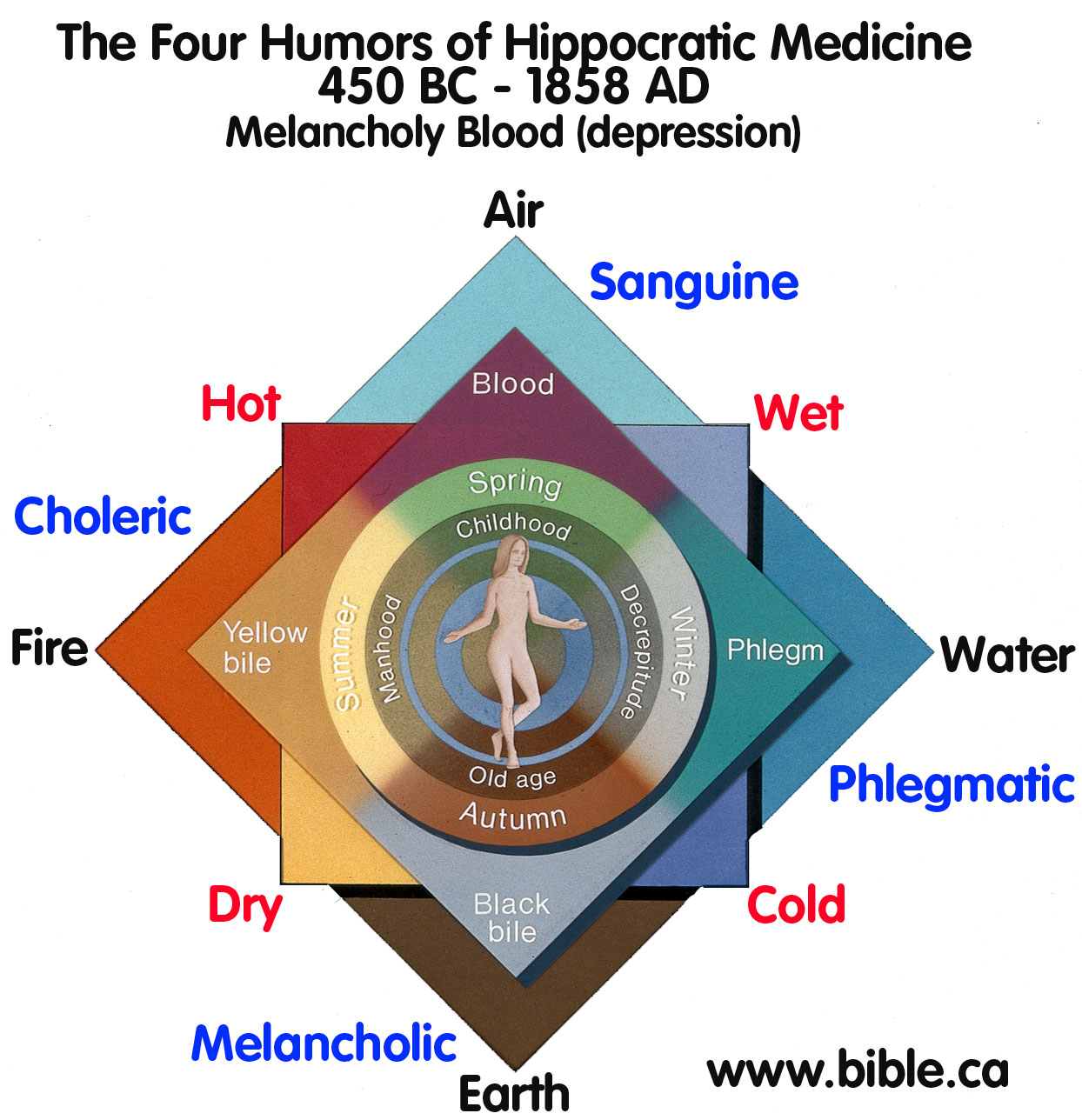The Four Humors of Hippocratic Medicine
|
Blood |
|
|
|
Introduction:
- It is important to always remember that any doctor before 1900 AD, had the equivalent "medical knowledge" of today's average 13 year old who has played with his chemistry set he got for his birthday and has dissected a few raccoons on his back yard picnic table. Apart from a crude knowledge of chemistry and a basic understanding of the physiology of the human body, doctors had everything else wrong.
- In 450 BC, Hippocrates invented the theory that all human ailments are caused by an imbalance of the "four humours": black bile, yellow bile, phlegm, and blood and that there were four basic personality types: sanguine (courageous, hopeful, amorous); choleric (easily angered, bad tempered), melancholic (despondent, sleepless, irritable), phlegmatic (calm, unemotional). Galen expanded this a bit, but since then, almost nothing changed until it went extinct in 1858 AD when Rudolf Virchow discovered the cell.
- Humoral era: The "humoralism" ran from Hippocrates in 450 BC down to 1858 AD when Rudolf Virchow discovered the cell. Humoral doctors believed health was based upon the balance of the four humors.
- At its core, humoral medicine is pure quackery. Nothing in this 2400 year old understanding of medicine was correct as to the cause of disease.
- Whereas all medical doctors swear the "Hippocratic Oath" to "do no harm", the paradox is that Hippocratic "humoral" medicine always caused much harm, suffering, pain and death. If I were a doctor today, I would refuse to swear an oath invented by a pagan Greek who in fact "did much harm". The oath starts "I swear by Apollo". Swearing allegiance to a demon who wants only to hurt and harm humanity, is an abomination. Anything connected with demons is not going to be good.
- "The writings of historians, physicians, journalists, and others addressing the history of psychiatry rest on three erroneous premises: that so-called mental diseases exist, that they are diseases of the brain, and that the incarceration of "dangerous" mental patients is medically rational and morally just. ... [Today's] plethora of drugs reflects the psychiatric view, now widely held, that the vexations of life are due to mental diseases caused by chemical imbalances in the brain, and that these can be effectively treated by a rebalancing of the chemicals. Two hundred years ago psychiatrists claimed that mental diseases were due to humoral imbalances in the body, including the brain, which could be rebalanced with appropriate physical treatments. No one has ever demonstrated the existence of diseases affecting the "mind," much less of humoral and chemical imbalances that were causing them. Unlike the history of medicine, the history of psychiatry consists largely of critiques of its own prevailing practices." (Coercion as Cure, Thomas Szasz, 2007 AD, p xii, 58)
- Although insanity was generally viewed by church ministers and medical doctors as being behaviour choices, some medical doctors believed insanity was an involuntary behaviour caused by an imbalance of the four humors. The church ministers got it right then and they still have it right today!
- Since the humoral era ended in 1858 AD, medical knowledge has exploded and most diseases were not only understood, but even cured! Psychiatry, on the other hand, has made absolutely no "scientific or medical progress" in knowledge like medicine. Scientists are completely unable to identify a biological cause or cure of insanity even today.
A. Humoral imbalances caused insanity:
- While it is true that some church ministers and most doctors both believed "melancholy blood" was the cause of depression, there was one huge difference. Some church ministers believed sinful living triggered Melancholy Blood, which in turn caused insanity.
- In 1670 AD, Richard Baxter, Church Minister, took the view that insanity and depression were caused by life circumstances, moral choices and sins of an individual, that induced bad "melancholy blood". Although his etiology is humoral, it is important to realize that he believed that sin and emotion actually were the foundational cause of melancholy blood, which then caused insanity! 1. sin. 2. bad blood. 3 insanity. "Root and Foundation, is usually a Depravation of the Mass of Blood, which is the Vehicle of the Spirits, and that is usually accompanied with some Diseases of the Stomach, Spleen, Liver" First on his list of causes of melancholy was: "Sinful Impatience, Discontents and Cares, proceeding from a Sinful Love of some bodily Interest, and from want of sufficient Submission to the will of God, and Trust in him, and taking Heaven for a satisfying Portion. This is one of the most common Causes". He then goes on to list things like: "when they are in Debt to others", "the secret Root or Cause of all this, is the worst Part of the Sin, which is too much Love to the Body and this World". He also identifies high self esteem and a lack of contentment as a cause: "not sufficiently humbled for our Sin, or else we should be thankful for the lowest State, as being much better than that which we deserved". He also identifies cognitive dissonance (bad conscience) as a trigger of insanity: "great Cause is the Guilt of some great and wilful Sin, when Conscience is convinced, and yet the Soul is not converted". His cure of insanity was to repent: "repent, to love God and your Neighbour, to live soberly, righteously and godly, to pray at all; here you must strive, and not excuse it by any Backwardness; for it is that which must needs be done, or you are lost". Although he believed typical Hypocrites junk medicine, he attributed depression and mental illness to freewill choices as the primary cause, which in turn cause the blood to become melancholy. So the real problem lay in fixing the mind, not the body! Repentance, he believed, would correct the melancholy blood and restore the person to normal. (The Signs and Causes of Melancholy, Richard Baxter, 1670 AD)
- So even in the humoral era, church ministers, with little medical training, were way ahead of the mad doctors.
- The four personality types of humoral medicine indicate states of insanity: "Sanguine", "Melancholic", "Choleric", "Phlegmatic"
- Melancholy was a synonym for our modern word depression.
- Choleric was a synonym for our modern word anxiety or mania. A newborn colic baby is restless, unhappy with both crying and screaming for no apparent reason. This modern medical term has its origin in humoral medicine and is directly connected with insanity. Colic = mania = the humor choleric.
B. Insanity treatments: Blood letting, vomits, blisters and cupping:
- In humoral medicine, disease and insanity was believed to be caused by an humoral imbalance of the four humors. The theory behind the treatments was that removing one of the humors would restore the imbalance.
- Strangely, blood was seen as a poison to be removed and
this is the origin of blood letting.

- Vomiting was induced by spinning machines and drugs in
order to remove phlegm

- Blistering and cupping were done to remove the clear
liquid of the blood (blood plasma) which they believed was making people
sick. To blister, you would apply sulfuric acid to the skin. Cupping is
where you apply a vacuum to a cup which is placed on the skin, which in
turn creates a blister under the skin of plasma.

- "How To Treat A Bedlamite: It may well be that, rather than his complicity in putting the inmates on display, what most indicts Monro's record at Bethlem is something else: the singularly unadventurous approach toward the treatment of patients that he and other medical officers continued to practice there for decades. Therapeutics at Bethlem was characterized by relatively uniform purges, vomits, and bleeding, administered seasonally to patients, with the occasional addition of tonics (such as alcohol), cold bathing (or other cooling applications), and warm or hot baths, all of these "heroic" interventions being supplemented by (a mostly "lowering" form of) diet and regimen. This model, whereby repletion in the system was countered by depletion, and vice versa, was founded on an essentially humoral approach to mental diseases. Overlaid since the late seventeenth century by a new, mechanistic brand of Newtonian science, older principles and even types of treatment had in reality changed remarkably little. To be sure, John Monro was skeptical of some conventional treatments: he objected to blistering, for example. This was a form of "counter-irritation" involving the application of a chemical preparation to draw out a blister on the head neck, shoulder, foot, or some other exposed part of the body, normally recommended to draw the peccant fluids and humors to the body's surface." (Undertaker of the mind: John Monro, Jonathan Andrews, Andrew Scull, 2001 AD, p 28)
Conclusion:
- Some church ministers, like Richard Baxter (1670 AD), believed sinful living triggered Melancholy Blood, which in turn caused insanity. It is clear that they rejected disease as a primary cause of insanity. For example, if you chose not to smoke, you will not get lung cancer. But lung cancer is caused by smoking, which is a moral choice. Likewise some church ministers believed that sinful choices caused the blood to be poisoned, which then caused insanity. The issue today, is that chemical psychiatrists believe a person randomly gets struck with a "mental disease" independent of moral choices. To them, it is like getting in a car accident and breaking your leg. Herein lies the fundamental error of modern psychiatry.
- "For the greater part of two thousand years, from the days of Hippocrates (c. 460-380 BC) until the Enlightenment, physicians and philosophers believed that diseases were caused by disturbances of four basic elements, called "humors": blood, phlegm, yellow bile, and black bile. Each humor was associated with a major organ of the body, as anatomy—influenced by astrology rather than by dissection—was then understood. Blood related to the heart, phlegm to the brain, yellow bile to the liver, and black bile to the spleen. Treatment consisted of methods presumed to restore humoral balance. Outgrowing old ideas is a gradual process. It is possible, however, to fix two dates that decisively mark the beginning of a new age in the definition, identification, and understanding of bodily diseases and of physical elements of which they are composed. In 1858, the German pathologist Rudolf Virchow (1821-1902) published his thesis Cellular Pathology as Based upon Physiological and Pathological Histology. For the next century, the standard scientific measure—the "gold standard"—of disease was bodily lesion, objectively identifiable by anatomical, physiological, or other physico-chemical observation or measurement." (The Medicalization Of Everyday Life, Thomas Szasz, 2007 AD, p 43)
- Mad doctors believed that harsh treatment of the body would restore the humoral imbalances and cure insanity.
- After the discovery of the cell in 1858 AD, the humoral medical theory ended. Medical science has mad huge gains in both diagnosing and treating bodily diseases.
- Psychiatrists, however, have made no progress in 500 years, since they are unable to find a single biological cause of even one mental illness or insanity.
- Now that humoral medicine is extinct we can look back and see that Church ministers during the humoral era were as far ahead of the doctors of their day in understanding insanity, as church ministers are ahead of the chemical psychiatrists of today. Since the humoral era ended in 1858 AD, medical knowledge has exploded and most diseases were not only understood, but even cured! Psychiatry, on the other hand, has made absolutely no "scientific or medical progress" in knowledge like medicine. Scientists are completely unable to identify a biological cause or cure of insanity even today. None of a psychiatrists 11 years of medical training help him in working with the insane, apart from the two week course on counseling. However their medical training is very helpful in drugging the unruly into submission, although this is not a "cure".
- The idea that insanity is caused by a chemical imbalance in the brain, is just as mythical as the extinct view that insanity was caused by a humoral imbalance in the brain. The humoral imbalances of historic mad doctors and the chemical imbalances of modern psychiatrists, is pure quackery, junk science and myth.
- Modern chemical psychiatrists continue to "do much harm" with their mythical "chemical imbalance in the brain" theory by treating the insane with 1. insulin comas, 2. electric shocks (ECT), 3. lobotomy, 4. drugs. All of these treatments cause brain damage.
- The latest string of junk pop psychiatry treatments include Transcranial Magnetic Stimulation (TMS, 1985), Vagus Nerve Stimulation (VNS, 2005), Deep brain stimulation (DBS, 2009). None of these ridiculous and misguided treatments work. Chemical psychiatry will soon be extinct and forgotten beside bloodletting in the museum of medical horrors.
- Insanity is a moral choice of behaviour, not a disease. Insanity happens in the spirit and has no biological cause. Body chemicals, may cause pain or pleasure, but do not directly control moral choices. To speak of "curing" insanity is as silly as speaking of "curing" chronic lying or adultery. Insanity is a collection of behaviours that other people find offensive, annoying or bothersome.
By Steve Rudd: Contact the author for comments, input or corrections.
Send us your story about your experience with modern Psychiatry


